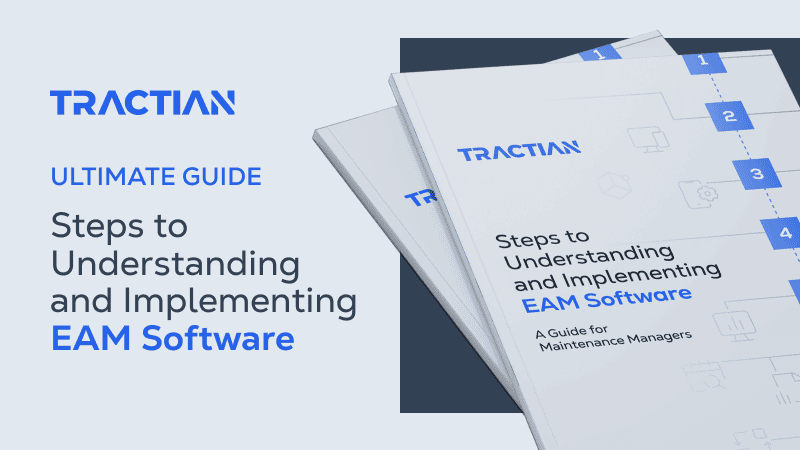When a critical piece of equipment fails unexpectedly, production stops, schedules slip, and teams scramble to find replacement parts that may take weeks to arrive. The costs add up and continue to compound far beyond the equipment repair bill.
Because the failure is unexpected, there’s no way to know what will be impacted in that moment, let alone when it will happen. But, what if you could see these failures coming months in advance? How dramatically would your strategy, planning-or even your entire operation change?
Gaining this future-telling level of insight is exactly what remaining useful life (RUL) calculations make possible. RUL gives maintenance teams a data-driven answer to one of their most important questions: how much time do we have before this asset needs attention?
So, instead of guessing when equipment might fail or following inflexible maintenance schedules, RUL enables teams to plan interventions based on the actual condition of their assets and predicted performance.
In this article, we'll explore how RUL estimation works, the different methods for calculating it, and most importantly, how to integrate these insights into maintenance planning that actually prevents downtime and reduces costs.
What Is RUL and Why Does It Matter
RUL is one of the most powerful predictive tools available today. The RUL of an asset represents the estimated time it can continue functioning effectively before requiring replacement or a major overhaul. RUL is typically measured in time units, such as hours, days, or years, or operational cycles, depending on the specific asset type and how it’s used.
Think of RUL like the fuel gauge in your car. It tells you how much further you can go before you need to stop and refuel. Except, instead of gasoline, we're talking about the operational capacity remaining in your equipment.
What does RUL mean in practice? RUL represents the time remaining before an asset reaches the end of its functional capabilities, moving from acceptable performance to a state where continued operation becomes unreliable or unsafe.
Industry relevance: This concept applies across various industries including manufacturing plants, utility companies, transportation systems, and infrastructure management, where equipment failure can have significant operational and financial consequences.
Business impact: RUL predictions directly affect how maintenance teams plan their work, allocate resources, and make financial decisions about replacement asset value.
The difference between knowing your RUL and guessing is the distinction between controlled maintenance and emergency repairs. When you understand how much useful life remains in your assets, you can schedule interventions during planned downtime rather than scrambling when something breaks unexpectedly.
RUL vs the Service Life of an Asset
Understanding the distinction between these terms prevents costly misunderstandings in maintenance planning. The service life or useful life of an asset is the total expected operational lifetime from the moment an asset is installed until it's retired, while RUL is the remaining portion from the current point in time.
Usage life differs from calendar life because equipment doesn't age uniformly over time. A pump that runs 24/7 in harsh conditions will have a different RUL than an identical pump used intermittently in a controlled environment, making usage-based maintenance more accurate than fixed intervals. The expected useful life is typically determined during asset procurement, based on manufacturer data and industry standards. But RUL is calculated during its operation using actual performance data and current conditions.
This difference matters because it changes how you approach and analyze maintenance decisions and helps explain why some assets outlast their expected service life while others fail prematurely.
How to Calculate the Useful Life of an Asset
Calculating RUL isn't a one-size-fits-all process, and the method you choose depends on what data you have available, how critical the asset is, and what your organization can realistically implement. There are three primary approaches that maintenance teams use, each with its own strengths and applications.
1. Lifetime Data
Historical lifetime data from similar assets provides the foundation for statistical RUL estimation. This approach uses patterns from past equipment performance to predict future behavior, similar to how insurance companies use actuarial tables to assess risk.
The method works by analyzing installation dates, failure records, operating conditions, and maintenance histories from assets that have already reached the end of their service life. Statistical models then use this information to estimate the remaining useful life of currently operating equipment.
This approach is most effective when you have large datasets from similar equipment, consistent operating conditions, well-documented maintenance and failure histories, and assets that exhibit predictable degradation patterns.
The main limitation is that it assumes current assets will behave like historical ones, which may not account for changes in operating conditions, maintenance practices, or equipment modifications.
2. Run to Failure Histories
Run-to-failure data focuses specifically on the operational parameters and conditions that led up to equipment breakdowns. Instead of examining entire asset lifecycles, this method focuses on the warning signs and degradation patterns that occur before failures occur.
This data includes vibration signatures, temperature trends, oil analysis results, and other measurable parameters that change as equipment approaches failure. By identifying these patterns, maintenance teams can recognize when current assets are following similar trajectories toward breakdown, making run-to-failure maintenance a strategic choice in certain scenarios.
The method excels in applications where equipment failures follow recognizable patterns and where condition monitoring systems can track the relevant parameters. It's particularly valuable for rotating equipment, such as motors, pumps, and compressors, where mechanical wear creates detectable signatures.
3. Threshold Indicators
Threshold-based RUL estimation uses measurable parameters that indicate equipment deterioration. When these indicators approach predetermined limits, the system calculates remaining useful life based on the rate of degradation and the distance to failure thresholds.
Common threshold indicators include vibration levels, temperature readings, oil contamination levels, electrical resistance measurements, and performance metrics such as efficiency and output quality. The key is establishing appropriate thresholds that reliably indicate when equipment is approaching the end of its useful life.
For example, by monitoring a bearing's vibration levels and tracking how quickly they increase over time, maintenance teams can estimate the remaining useful life before the bearing is likely to fail.
The calculation becomes: RUL = (Failure Threshold - Current Value) / Degradation Rate
This method requires continuous condition monitoring to track indicators and sophisticated analysis to determine degradation rates. However, it provides the most responsive and accurate RUL estimates when implemented correctly.
Benefits of Estimating Remaining Useful Life
Accurately estimating RUL transforms maintenance from a reactive scramble into a strategic operation that drives real business value. The benefits extend far beyond the maintenance department, directly impacting production efficiency, cost control, and operational reliability.
Reduced downtime: RUL estimation enables maintenance teams to schedule interventions before failures occur, thereby eliminating the unpredictable downtime associated with equipment breakdowns. Instead of losing production time to emergency repairs, teams can plan preventive maintenance during scheduled shutdowns or low-demand periods.
Optimized maintenance scheduling: Knowing when equipment will likely require attention enables maintenance planners to coordinate multiple activities simultaneously, maximize the use of skilled technicians, and ensure that parts and resources are available when needed, making maintenance KPIs valuable for assessing the effectiveness of scheduling.
Extended asset lifespan: Proper maintenance based on RUL can significantly extend overall asset life by preventing the cascading damage that occurs when equipment is allowed to run to failure. Early intervention often means smaller repairs that preserve the asset's structural integrity.
Cost savings: RUL estimation prevents both premature replacements that waste remaining useful life and catastrophic failures that require expensive emergency repairs and replacement parts. The financial impact includes reduced overtime costs, lower inventory requirements, and better capital planning.
Improved reliability: When maintenance is based on the actual condition of the asset rather than arbitrary schedules, overall system reliability increases because interventions occur when they're actually needed, rather than too early or too late.
Better resource planning: RUL information enables more accurate budgeting and resource allocation by providing advanced notice of upcoming maintenance requirements, allowing organizations to plan for parts procurement, contractor scheduling, and budget allocation.
The cumulative effect of these advantages is a maintenance operation that supports business objectives rather than simply responding to equipment problems. This approach aligns well with RAM analysis to optimize reliability, availability, and maintainability.

Key Challenges in Determining RUL
Despite its clear benefits, accurately estimating RUL presents several challenges that maintenance teams must navigate carefully. Understanding these limitations helps set realistic expectations and guides implementation strategies.
Data quality and availability issues top the list of challenges because RUL calculations are only as good as the information they're based on, and using an FMEA Spreadsheet helps teams focus on the most critical failure modes. Incomplete maintenance records, inconsistent data collection practices, and gaps in historical information can significantly impact the accuracy of predictions.
Variations in operating conditions affect predictions because equipment that operates under different loads, temperatures, or environmental conditions will have different degradation patterns. A motor that runs continuously at full load will have a different RUL than an identical motor used intermittently at partial load.
The complexity of modern equipment and systems creates challenges because today's assets often have multiple failure modes and interdependent components. A single RUL estimate may not capture the various ways equipment can fail or the interactions between different subsystems.
Balancing accuracy with computational requirements becomes important when dealing with large numbers of assets or complex analytical models. More sophisticated calculations may provide better predictions but require more processing power and specialized expertise to implement and maintain.
Integrating RUL estimates into existing maintenance workflows requires adjustments to established procedures and may encounter resistance from teams accustomed to traditional approaches. The challenge lies in demonstrating value while managing the transition to new methods.
Integrating RUL Into Maintenance Planning
Moving from RUL calculations to practical maintenance improvements demands a systematic integration into daily operations and long-term planning processes. The goal is to make RUL information actionable rather than just informational.
Scheduling Tasks in Advance
RUL estimates transform maintenance scheduling from reactive to proactive by providing advanced notice of upcoming needs. Teams can plan work during scheduled downtime windows, coordinate multiple maintenance activities on the same equipment or production line, and prepare necessary parts and resources well before they're needed.
This advance planning minimizes impact on production schedules because maintenance can be aligned with natural breaks in operations rather than forcing unplanned shutdowns. It also facilitates better coordination between maintenance, operations, and procurement teams.
Resource Allocation
RUL information fundamentally changes how maintenance resources are allocated by providing data-driven priorities for spare parts inventory, maintenance staff scheduling, and budget allocation decisions between repairs and replacements.
Instead of maintaining large inventories "just in case," teams can stock parts based on predicted needs derived from RUL estimates. Staff scheduling becomes more efficient because technicians can be assigned to upcoming work rather than waiting for emergency calls to arrive.
Budget allocation improves because RUL data helps justify maintenance investments and supports decisions about whether to repair aging equipment or replace it with newer, more efficient assets.
Real Time Data Analysis
Modern maintenance management systems use continuous monitoring to update RUL estimates as new data becomes available, detect sudden changes in asset health that may indicate accelerated degradation, and provide alerts when intervention is needed.
This real-time capability ensures that RUL estimates remain current with actual equipment conditions, rather than becoming outdated predictions. When integrated with maintenance management systems, RUL data automatically triggers work orders, updates maintenance schedules, and adjusts resource planning.
The result is a maintenance operation that responds dynamically to changing equipment conditions while maintaining the predictability that comes from advanced planning. Adopting Reliability-Centered Maintenance frameworks can further streamline this approach by focusing on critical assets and failure modes.
How Tractian CMMS Transforms Remaining Useful Life Into Action
Understanding remaining useful life is valuable in its own right. But turning that knowledge into better maintenance outcomes requires the right tools and systems. Most teams don't see estimated remaining life translate into better maintenance results because they lack the infrastructure to effectively act on RUL predictions.
Tractian CMMS bridges the gap between RUL calculations and practical maintenance improvements by providing a platform that makes predictive maintenance accessible and actionable. The system integrates RUL estimates directly into work order management, maintenance scheduling, and resource planning processes.
Instead of keeping RUL data in separate spreadsheets or reports, it becomes part of the daily workflow that maintenance teams already follow. Tractian CMMS automatically updates maintenance schedules based on changing RUL estimates, ensuring that interventions happen at optimal times rather than following rigid calendar-based schedules.
The platform also provides the data collection and analysis capabilities needed to improve RUL accuracy over time. By tracking actual equipment performance against predictions, teams can refine their models and develop more accurate estimates for similar assets.
Ready to transform your maintenance strategy with data-driven decisions? See how Tractian CMMS helps you build a more reliable, efficient, and insight-driven maintenance operation.


